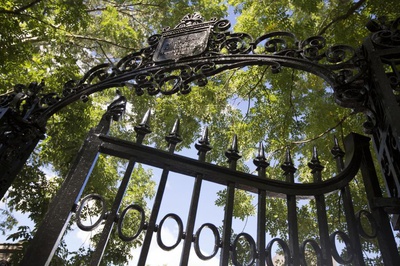
News
Harvard Grad Union Agrees To Bargain Without Ground Rules

News
Harvard Chabad Petitions to Change City Zoning Laws

News
Kestenbaum Files Opposition to Harvard’s Request for Documents

News
Harvard Agrees to a 1-Year $6 Million PILOT Agreement With the City of Cambridge

News
HUA Election Will Feature No Referenda or Survey Questions
Recent Graduate Discovers Comet
A recent graduate of Harvard scanning the California sky found a "star out of place" last Sunday night.
Stephen Kilston '65 had discovered a comet, the first one found in nine months.
The young graduate student in astronomy had not been looking for comets -- he was using a 24 in. telescope at the Lick Observatory in San Jose, California to study the colors of certain stars.
About four or five comets are discovered in an average year, according to Brian Marsden of the Smithsonian Astrophysical Observatory: approximately half by amateurs who make a habit of searching for them. "This has been an unusually slow year," he said.
Comet Kilston
Comet Kilston -- the discoverer always gets the comet named after him -- too faint to be seen by the naked eye, and will probably remain invisible. With telescope, it can be picked up in the southern sky at mid-evening, seemingly moving to the southeast.
Kilston sent a telegram describing his discovery to the Smithsonian, which acts to the international clearing house for heavenly breakthroughs.
A few times a year, Marsden said, "we get telegrams which lead nowhere. Last week, one man claimed to have discover- ed a colossal nova, but it turned out to be the planet Saturn. It usually taken a fey seconds of observation to find the false alarm."
"But sometimes," he continued, "we have to examine the body for as much as fifteen minutes to tell." And on rare occasions, the Smithsonian will itself be fooled, passing on a false discovery as a true one.
It is a good deal easier to find comets then to understand them. Scientists is know, however, that all observed comets are part of the solar system -- that is, they revolve around the sun. They will not all remain in our solar system: it is known that certain ones will eventually escape, perhaps to be picked up be another star. It has been estimated that there are a hundred billion comets in orbit, Marsden said.
Scientists are less sure what comets look like. They weigh perhaps a trillion tons, or one billionth the mass of the earth. There is probably a central region, or nucleus, of about five miles of solid material. This could be one solid rock or a collection of rocks. Some scientists think there is no nucleus at all.
Surrounding the "nucleus" is a vast expanse of dust particles, which could be as huge as 100,000 miles across. The tail is similar in structure, and may be as long as 200 million miles, although some comets have almost no tail at all
Want to keep up with breaking news? Subscribe to our email newsletter.
From Our Advertisers

Over 300+ courses at prestigious colleges and universities in the US and UK are at your disposal.

Where you should have gotten your protein since 1998.

Serve as a proctor for Harvard Summer School (HSS) students, either in the Secondary School Program (SSP), General Program (GP), or Pre-College Program.

With an increasingly competitive Law School admissions process, it's important to understand what makes an applicant stand out.

Welcome to your one-stop gifting destination for men and women—it's like your neighborhood holiday shop, but way cooler.

HUSL seeks to create and empower a community of students who are seeking pathways into the Sports Business Industry.
